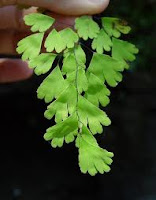Pawpaw, Asimina triloba, loved by Zebra Swallowtail Butterflies

The flowers of Pawpaw, Asimina triloba, are downward facing so you have to keep an eye out for them or you will miss their sweet beauty in the spring. Ours is blooming now and has been for the past 2 weeks. In order to get fruit, you have to have 2 cultivars. We don't care about fruit since we planted the tree solely for the zebra swallowtail butterfly's visits. For our purpose a seed started tree was just fine. For fruit, look for grafted cultivars. Some protection from the worst of summer's sun and excellent drainage are critical to their success. Since it is a small tree, ours is in the herb bed with a bird bath and a few native plants. KY State University Pawpaw Planting Guide is at this link Excerpts- "The pawpaw is a tree of temperate humid growing zones, requiring warm to hot summers, mild to cold winters, and a minimum of 32 inches (81 cm) of rainfall spread rather evenly throughout the year...






.JPG)



